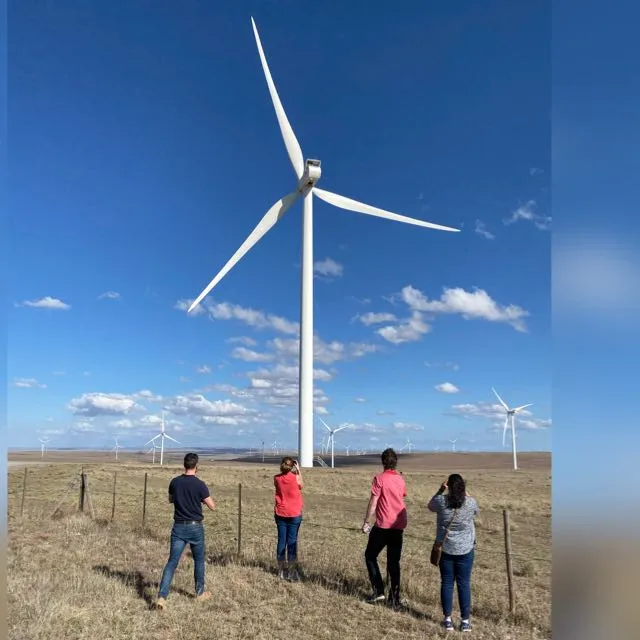Hello everyone on HIVE! I hope you are well! My name is Jasper and I’m writing to you from Cape Town, South Africa. Since I’ve joined HIVE, my main post topics have been about my two main hobbies, namely writing and performing music, and surfing the various spots scattered around my hometown! Between my cute cats, and my beautiful baby daughter, there’s usually some other material as well!
What I haven’t posted much about yet is my day job that I’m also passionate about! I work for a renewable energy developer. It is our job to look across South Africa for potential sites where new wind or solar PV facilities could be developed.

Myself (tall man in pink), and three colleagues stop to look at an operational wind farm before carrying on to explore some potential new sites…
This is particularly important in South Africa, because quite frankly, we are on the brink of an energy crisis:
•The Sasol factory is apparently the biggest single source of CO2 in the world. Many other significant industries here, such as our reliance on mining, are very energy intensive as well. I think this means that South Africa is one of the worst contributors to climate change (when compared to its fairly small GDP).
•Our State-owned Energy Facility, Eskom, has been struggling to maintain the countries’ old coal fired power plants which make up over 90% of the country’s electricity supply. Because of this, for the last decade, there have been times when South Africa has suffered rolling blackouts for weeks at a time. We need something to replace these coal power plants urgently as several of them are on their last legs and have been operating past their original planned lifespan for years already.
•Eskom is in dire financial straits… they can’t really afford to build any new power plants themselves. If they were a private company, they would have to declare bankruptcy, but as a State Owned Enterprise, they keep getting bailed out and are just able to survive… barely.
Luckily, South Africa has some great solar resource – it gets very sunny here compared to Europe. We also have several provinces with great reliable wind resource as well! Because of this, between 2012 and 2015, South Africa had four rounds of Government tenders for private companies to propose to build wind and solar PV sites, and then sell the power to Eskom per kWh. This means that the huge capital expense of building the energy facilities was taken off Eskom, and they only had to commit to buying the power for 20 years.
These Government tenders were very competitive – by the fourth round, both wind and solar facilities could be built and sell power to Eskom cheaper than Eskom could build new “old-fashioned” coal fired power plants themselves.
And then politics happened…
… and the yearly Government tenders stopped.
Many companies like mine could not last while they waited for things to get better again. Some disappeared altogether. Others had to retrench most of their staff. Luckily, at that time, my company only had a handful of South African employees, and our European Mother Company managed to provide funding to keep us afloat!
And then, in 2021, the Government finally started to have Renewable Energy Tenders again! Just last week, the president said two encouraging things:
•They are going to make this year’s Government Tender twice as large as normal, so that 5.2GW of renewable energy will be awarded instead of the originally planned 2.6GW.
•They are going to take steps to make it easier for large private companies like mines to purchase power from private renewable energy facilities directly, even if the power still must be “wheeled” over the Eskom grid for a small “wheeling tariff”.
So, hopefully my job has a positive future now… but what are some of the challenges?
Finding the best new sites requires several things to go your way all at once:
•The landowners have to want it. We offer them financial compensation for having solar panels or wind turbines on their land and try to choose farms that have been used for low intensity grazing of livestock (rather than crops), so that the normal farming operations can continue on the rest of the land, at the same time as the farmer making some extra money.
•There must be a good resource. In order to be competitive you have to choose places where the wind blows well or the sun shines with good average intensity! South Africa is great at both compared to Europe, but some places are better than others!
•There must be a way for the power to be put onto the grid. Somewhere nearby, there must be powerlines or a substation with grid capacity available. This is a big challenge in South Africa – many of the best places don’t have any grid lines, or the grid is constrained and can’t take on any more power from a proposed new renewable energy facility. Unfortunately, Eskom is struggling to keep up with the planning and budget needed to build new grid capacity in the right places for us.
•There must be few environmental constraints. You can’t put turbines too close to vulture colonies or large eagle nests as these big raptors are prone to collisions. You certainly can’t place a solar panel farm where it is feasible for crops to be grown as South Africa’s Department of Agriculture needs to ensure food security as well.
Are there enough places like this? I am struggling to see where enough wind and solar farms will go to satisfy South Africa’s needs and end the rolling blackouts, unless Eskom manages to put significant money into upgrading the grid infrastructure and key substations in the right places. Where will that money come from?
At the end of the day, we need to solve South Africa’s energy crisis… if we don’t, the consequences could be very bad indeed.
THE END
